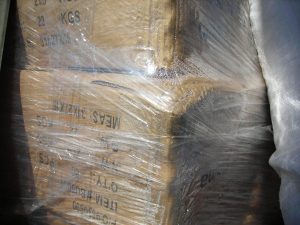Have you ever encountered this scenario? “My container arrived and the cargo inside is wet. There are no holes in the container and the interior stinks of mold and mildew. It also looks like it’s raining from the ceiling of the container. How did this happen?”
If your container was loaded in a tropical environment, where the air was warm and humid, then shipped to the United States, where temperatures were far cooler, your cargo may have experienced a phenomenon known as “cargo sweat” or “container rain.” Differences in temperature of as much as 50°C can occur at certain times of the year between tropical regions and the cooler, temperate climate of the U.S. As the outside temperature drops, the container’s contents cool, causing hygroscopic or moisture absorbing cargo and packing materials to release water vapor. The cool temperature inside the container prevents the water vapor from being absorbed into the air. This happens as the temperature of the container’s top and side panels falls below the dew point of the air trapped within the container, and like the dew running down a glass of iced tea on a hot summer’s day, condensation or “sweat” begins to form on the cargo and the inner ceiling and walls of the container. If there is enough moisture riding along with your cargo and packing materials, given the right heating and cooling cycles in the container, the vapor release could be so significant that it would seem to be “raining” from the ceiling.

“Sweat” has formed on the inside of a shrink wrapped pallet.
As warm, moist air is cooled below its dew point, water vapor in the air is transformed to condensation, sometimes in large enough amounts that it penetrates the same packing materials the vapor was released from. Water from the ceiling may fall directly on the cargo or drip down the walls, pool on the floor, and be reabsorbed by the cargo or packing materials. The resulting damage will be attributed to the inherent vice of the cargo or packing materials, and may not be covered by filing a cargo claim.
To avoid cargo sweat/container rain, there are several factors that must be considered. First, if you are loading cargo in warm and humid environments, you should understand the temperature fluctuations that your cargo may be subjected to for any given voyage. Next, you should understand the hygroscopic or moisture absorbing properties of your cargo and the material used to package it. Cargo with a high fibrous construction (such as cotton, apparel, jewelry boxes, etc.) will hold a certain amount of moisture at origin that can be released under the right cooling conditions. If your cargo and packaging are not hygroscopic, then you have little to worry about. Lastly, the type and amount of cardboard used can greatly contribute to moisture release.
If your factors are such that there is a high probability of sweat or rain, you may want to consider using desiccant in the container to wick moisture from the air before it becomes a problem for your cargo. For the best results, desiccant bags should be hung evenly throughout the container. Most desiccant manufacturers have guidelines for their products that will help you determine the type and number of units to deploy.
Ventilation is another fix; although ventilated containers are hard to come by and typically committed to specific bulk cargo that originates in the tropics, such as coffee, seeds, beans and nuts. If transporting retail goods, you will be better served by hanging desiccants.
Plastic barriers used to enclose inner packing can help prevent damage from cargo sweat or container rain, but must be used with caution since they may also trap moisture inside—particularly if they enclose hygroscopic cargo or packing materials. The best policy is to use a plastic barrier on the innermost confines of cargo that is not hygroscopic. An example of this would be electronics wrapped in plastic, supported in styrofoam, and contained within a carton. Since the electronics are not hygroscopic, the plastic barrier protects against water coming from the outside without fear of trapping vapor on the inside.
You may not be able to prevent cargo sweat or container rain, but by paying attention to the details of your shipment, you may be able to reduce the likelihood of their occurrence.
MGTA helps companies identify, manage, and mitigate risk in their supply chain. Click here to learn more about our risk management services.
© 2013 Mohawk Global Trade Advisors



